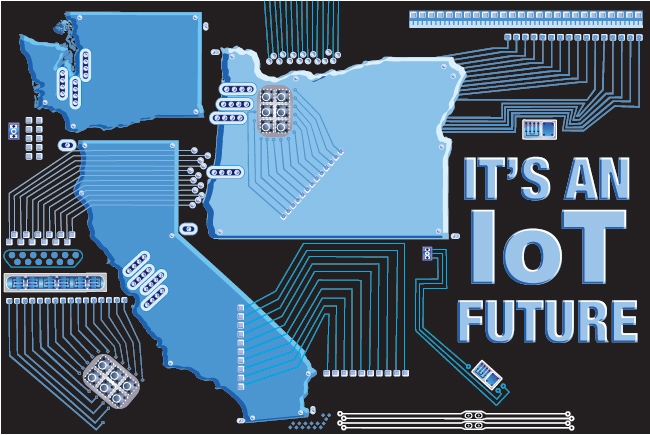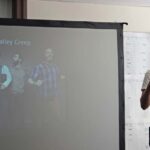How Oregon is poised to become the center of a revolution in smart factory technology.
At its Hood River manufacturing facility, Full Sail Brewing produces the equivalent of more than 30 million bottles of beer a year. Employees on the shop floor go through a careful process to set up the machines so that the beer is poured into the bottles correctly. There is not much room for error. A blip in the start-up process can cause hefty bottle loss and wasted labor cost.
Mark Moreland, president of Full Sail Brewing, foresees a day when employees can pull up an app on their smartphones that shows them the status of the machines. Sensors or small probes attached to each machine would send data via the internet to employees’ phones or to a PC. Workers would be able to click through the app to check that each start-up step has been completed — much like they would do with an old-fashioned clipboard. The app could also alert workers to an issue or predict if a machine is about to break.
Moreland’s vision is the application of the internet of things, or IoT as it is commonly known. In manufacturing, it is essentially a network of sensors that collects data on machines or physical assets in the factory. That data is then sent to the cloud, where computers can track the machines or products and their performance, and eventually predict if the machine is going to fail. Computer programs can even tell the machine to turn off before it breaks.
Moreland’s dream of a smart factory where the internet of things is fully operational is a vision at this point. But the technology is evolving rapidly, and one day he will have it running in his factory, he says.
Oregon is well placed to become a center of excellence for industrial IoT. The state has a strong manufacturing sector, which is growing more quickly than the rest of the country. Oregon has the second-highest portion of manufacturing jobs per capita. Since March 2010, manufacturing employment has grown 18.6% compared with the nation’s 8.7%, accordingto the State of Oregon Employment Department.
Oregon is also a hub of technical expertise in industrial IoT. Its proximity to cloud computing expertise in Seattle — Amazon is a leader — and software expertise in Silicon Valley and the Bay Area makes it an ideal test bed for the industrial IoT revolution. In Oregon Intel is a leader in smaller sensor manufacturing.
“There is a nice nexus of forces here: the accessibility to the vanguards of software and the accessibility to the vanguards of cloud. And in our own backyard, we have the vanguards of small sensors and chips,” says Tony Rost, chief technology officer at Portland technology company Metal Toad.
 Tony Rost, chief technology officer at Metal Toad
Tony Rost, chief technology officer at Metal Toad
Increased interest from software developers in industrial IoT inspired the formation in May of PIE Shop, a Portland incubator for entrepreneurs seeking to build IoT solutions. Technology accelerator Portland Incubator Experiment and tech firms Autodesk and Uncorked Studios partnered on the project. “We are starting to see more folks exploring industrial IoT,” says Rick Turoczy, co-founder of the Portland Incubator Experiment.
A big driver in the adoption of IoT will be the maturation of blockchain technology. Blockchain can play an integral part in industrial IoT because it is essentially a database that can be used to track the chain of custody and provenance of physical products. This makes it useful for manufacturers that have large supply chains. Maersk, the Danish container-shipping company, uses IoT and blockchain to track its assets.
Portland is vying to become a center of blockchain excellence. A new initiative to help blockchain entrepreneurs, Oregon Blockchain Venture Studio, was founded in Portland in the fall. Jeff Gaus, founder of the venture studio, says he chose to set up shop in Portland because of the technical expertise in the manufacturing of sensors, as well as the state’s strong manufacturing base.
“Portland is where geography and culture and embedded industry all collide into one place,” says Gaus.
At Metal Toad’s downtown Portland office, Rost shows me the company’s small lab where staff test the microchips and sensors that it develops as part of its IoT product line.
The use of IoT in heavy industry makes up 70% of Metal Toad’s revenue. The cheapness of IoT infrastructure is a driver behind more manufacturers showing interest in IoT solutions, says Rost. Sensors and cloud storage are now measured in “pennies,” says the technologist.
“We started as a digital agency, but because of our customer base in Portland and Oregon, we pivoted more into heavy industry,” he says.
 Metal Toad employees at the tech firm’s downtown Portland office
Metal Toad employees at the tech firm’s downtown Portland office
Rost sees big opportunity for smaller manufacturers, in particular, to adopt IoT because most operate on tight margins, and smart factory technology allows manufacturers to wring out efficiencies.
“Manufacturing is a tough business. When there is a subtle change or fluctuation in macroeconomics, like the trade war on steel, manufacturers have huge hits to the top line,” says Rost.
One of the biggest opportunities the technologist sees in IoT is its ability to predict failure of machines — a benefit that Moreland at Full Sail Brewing is particularly attracted to. If companies can detect in advance that an engine is going to break, new parts can be ordered and delivered before the machine breaks down.
“Predictive failure is where the real money is. That revenue stream will be stable,” says Rost. “It enables the company to have stability.”
It is not just manufacturers that are turning to IoT solutions. The companies that lease space to manufacturers are also looking at providing IoT as a service, much like commercial building owners provide Wi-Fi.
Portland technology company Rigado specializes in IoT solutions in the commercial and manufacturing sectors. One of its clients is a large warehouse operator, which owns the building a manufacturer operates out of.
“We are seeing warehouse tenants do smart manufacturing. Manufacturers expect to see Bluetooth connectivity and the ability to connect to Bluetooth devices, gather data and send it to the cloud. They expect that in their warehouse,” says Kevin Tate, chief revenue officer at Rigado.

Kevin Tate, Rigado
A number of Rigado’s customers also use IoT to track equipment on their shop floors as a way to keep track of valuable assets. One of their clients uses sensors to track power tools, for example.
“It raises an interesting question: Who is responsible for making that connectivity available to the smart manufacturer? Is it the manufacturer themselves, or is it the space they are in, or does it go downstream to the equipment itself?” asks Tate.
Oregon’s agricultural sector also stands to benefit from IoT. Small farms are using sensors to detect insects and measure soil moisture, a sector known as precision agriculture.
And in the food-processing sector, IoT is useful for maintaining quality and food safety. It can be used to keep track of the temperature of refrigerated food, for example, from its source to the plate, a system known as cold chain.
The ability of industrial IoT to take over manufacturing processes has some concerned about widespread job losses. But supporters of the technology see it as an opportunity to transform manufacturing employees into skilled technologists.
The nature of Oregon’s manufacturing sector shields it from the job losses that have occurred in other parts of the country. Because manufacturing is mostly bespoke in Oregon, the sector is still not highly automated. Heavy manufacturers have been slow to introduce robotics, for example, because the bespoke nature of their businesses means workers still play a big role.
Moreland at Full Sail Brewing does not think IoT will supplant his workers. People will still be required to set up and manage the machines, he says. The technology will just make them more efficient at their jobs, he argues.
Rost at Metal Toad joined Gov. Brown’s Oregon Workforce and Talent Development Board to advise state officials on how to transition the workforce through technology advances.
One opportunity he sees for workers who are displaced from advances in smart factory technology is giving them the possibility of working remotely. The vast amounts of data collected by IoT sensors and sent to the cloud will require technologists to analyze this data. This kind of work can be done remotely rather than on-site.
For a remote workforce to become a reality, Oregon’s internet infrastructure needs to be built out, especially in Eastern Oregon, where connectivity is still spotty. The advent of 5G cellular will be a game-changer by allowing more employees to work off-site.
“We are building out infrastructure here so remote working is possible. Rural communities can start joining in a larger, higher-paying, stable global community of technology and technologists,” says Rost. “Oregon should be a role model for how we shepherd in the technological revolution.”
Rost has spoken to Portland Community College about the need for more technologists who specialize in manufacturing. “It is not like we need more programmers. We need more maintenance workers who can program. We don’t need more programmers, we need more electricians who can program, and product engineers who can program.”
Ultimately, the advance of technology means every company, not just manufacturers, will have to train workers in using technology.
“Everyone is on the path to becoming a tech company,” says Turoczy.
Despite the efficiencies that industrial IoT can bring, it is not widely deployed in manufacturing. Moreland at Full Sail Brewing worries that rigging his manufacturing facility with IoT smart technology will take time he does not have and will distract his lean workforce.
“IoT is moving faster than businesses can keep up with,” says Moreland.
Nevertheless, the executive wants to fully outfit his factory with IoT eventually. “I can see where it is going and want to get there,” he says.
Other manufacturers are on the verge of accepting IoT into their factories. Andrew Loder, president of Wilbur-Ellis Feed — manufacturer of nutrients for livestock, pet food and aquaculture — says IoT is “not out of the realm of possibility” inside the company’s factories.
Wilbur-Ellis Feed recently installed an automatic palletizer in its Clackamas facility. “We constantly look at automation. In the environment we are competing in, being most effective and most efficient is critical,” says Loder.
Ultimately, competitive pressures will require manufacturers to adopt smart factory technology, say experts. Much like the trucking industry is being upended with the advent of self-driving trucks, and the taxi sector has been forever changed by ride-sharing technology, manufacturers are the next sector ripe for disruption.
“It is important that manufacturing executives ‘do an Uber’ on themselves and disrupt themselves to get ahead of the game,” says Rost. “It is not good anymore to sit on the existing revenue streams and assets; you have to prove you are innovating.”
Gaus at the Oregon Blockchain Venture Studio says it is still early days for the adoption of industrial IoT, because a confluence of factors that are essential for widespread adoption of IoT are only now coming together. It is only in the past 24 months that the price of smart sensors has become cheap. It is also only in the past 24 months that we are starting to see the arrival of the “always connected stage in this country with the pending advent of 5G wireless,” says Gaus. Blockchain technology is also just reaching the stage of commercial deployment.
But that doesn’t mean the newness of the technology is a reason for manufacturing executives to sit on their laurels.
“Five years from now, you will see massive changes in IoT and its adoption in the manufacturing sector,” says Gaus. “It will propel companies that otherwise wouldn’t be that competitive to the forefront. And it will disrupt those who are slow to adopt.”
To subscribe to Oregon Business click here.






